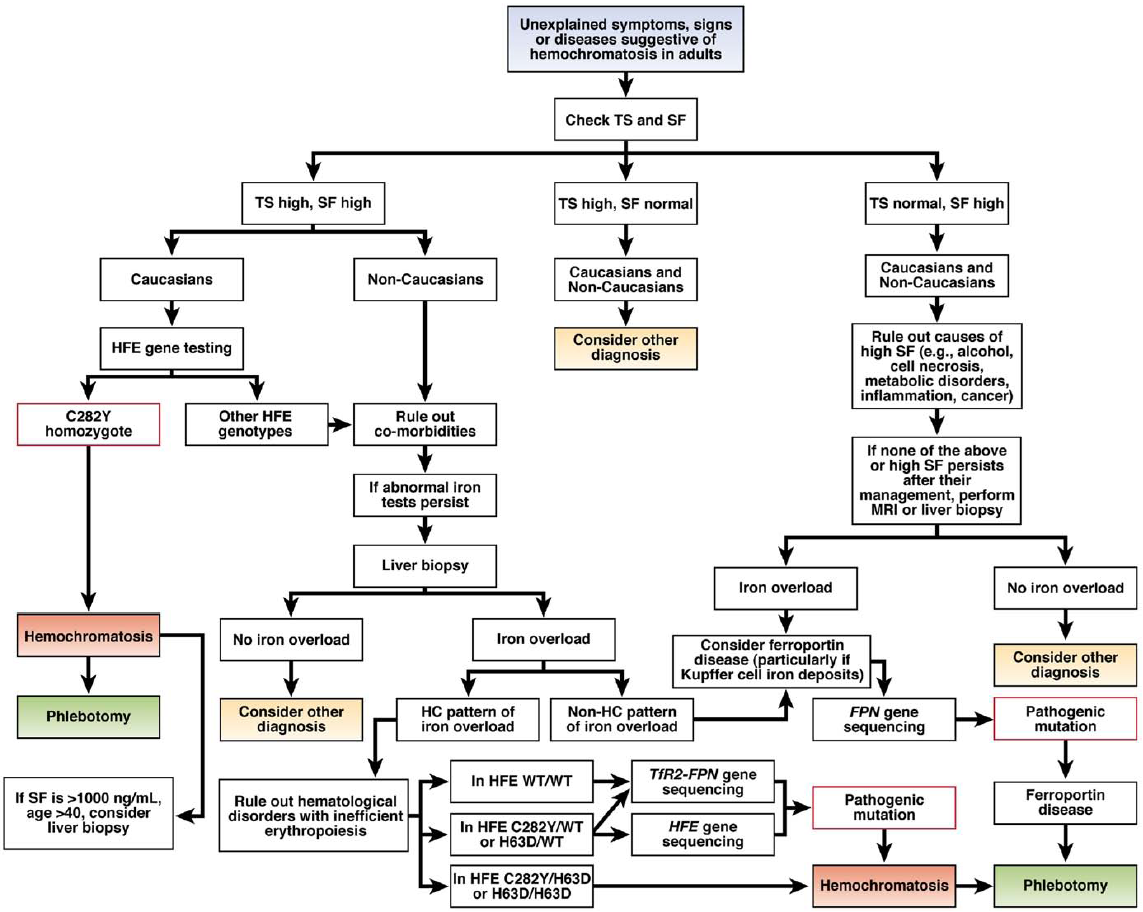Hemochromatosis
Work in progress!
Hemochromatosis is a hereditary disorder that leads to an iron overload in organs due to an increased iron absorption from food. It is caused by a point mutation in one of several genes.
Contents
Phenotype
The hemocromatosis phenotype and its harmfulness varies in patients. Symptoms are caused by a toxic iron accumulation in parenchymal cells of important organs, e.g. heart, liver, endocrine glands. The disease is usually diagnosed in middle aged patients. Based on the affected organs, the symptoms range from simple biochemical abnormalities to severe diseases such as heart failure and liver cirhosis.
The individual phenotype varies that much, because the genetic background only gived a predisposition to hemochromatosis. Human and environmental factors play an important role as well. For example, C282Y HFE homozygous individuals that drink extensive alcohol have a much higher penetrance to develop a hemachromatosis-related liver cirhosis. In general, male have a higher probability of developping hemochromatosis, supposedly because of female menstruation.
Clinical representation are includes:
- tiredness
- joint and bone pain
- destructive arthritis
- liver fibrosis and cirrhosis, increased risk to develop hepatocellular carcinoma
- Glucose intolerance and insulin resistance due to damages in the pancreas (many patients have diabetes mellitus).
- Gonadal dysfunction, hypogonadism and decreased libido.
- heart failure, arrhythmias or pericarditisheart failure
- grey or dark cutaneous (skin) pigmentation
| form | male/female | age | non-/caucasian |
|---|---|---|---|
| HFE | male | 40-50 years | caucasian |
| TfR2 | male or female | 30-40 years | caucasian or non-caucasian |
| HJV, HAMP | male or female | 15-20 years | caucasian or non-caucasian |
| Ferroportin disease | male or female | 10-80 years | caucasian or non-caucasian |
Biochemical disease mechanism
The basis for hemocromatosis is a hepcidin deficiency. Hepcidin is a protein that is responsible for the downregulation of iron entry into the bloodstream. Patients do not suffer from a perturbance of the iron metabolism, which works normal, but from an increased iron uptake into the blood.
Iron Metabolism
Iron is only able to enter the human body in the small intestines.
Genetics and Inheritance
There are several different types of hemochromatosis. Each type is connected to defects in the iron uptake regulation through hepcdin. The most common and less severe type is caused by a mutation in the HFE gene on chromosome 6. The other types are rare and based on a mutations in the TfR2 gene or, in the case of juvenile hemochromatisis, mutations in the HJV or HAMP (Hepcidin) gene. Mutations in the FPN(Ferroportin) gene can also result in hemachromatosis like symptoms, but it is often termed ferroportin disease. The mutations leads to a hepcidin resistance and thus to an iron hyperabsorbtion from the diet, although the hepcidin production is not impaired in this patients.
Homozygosity for one of the above mentioned mutations only results in a certain predisposition to hemochromatosis, but not all persons with this genetic background develop the disease.
Mutations
HFE: C282Y
TfR2: Y250X (nonsense)
HJV: G320V
HAMP:
FPN: C326S and C326Y
Reference sequence
Neutral mutations
Disease causing mutations
Diagnosis and Treatment

Hemochromatosis is diagnosed in patients with an unnormal high transferrin saturation (TS) and, in later stages, increased serum ferritin levels. The transferrin saturation denotes the concentration of free iron in proportion to the concentration of transferin in the blood serum. However, the diagnosis should always be supported by a gene test for HFE C282Y homyozygocity. Inflammation, metabolic disorders, diabetes mellitus, alcohol abuse and liver cell necrosis can also lead to an increased serum ferritin level. On the other hand, a finding of normal serum ferritin level alsways excludes hemochromatosis.
Since iron can only be removed from the system by blood loss, the only possible treatment is phlebotomy (bloodletting). It is aimed to reduce the iron content in the body. The first step of the iron-depletion treatment is to induce a slightly iron-deficient state in the body. Therfore, 400-500 ml blood are removed weekly. After 1 to 2 years a serum ferrition level of 20-50 μg/l is reached. In the long term, a maintenance therapy with two to four phlebotomies a year is then enough to keep the serum ferritin level between 50-100 μg/l.
A low iron diet can help. The life expectancy of dignosed and treated hemochromatosis patients withour complications is comparable to that of the normal population. But early diagnosis and initation of therapy increases survival time.
Resources
The entry is based on several resources:
http://www.gastrojournal.org/article/S0016-5085%2810%2900872-3/fulltext